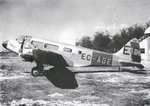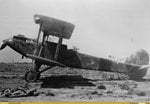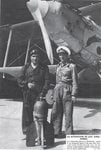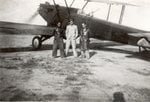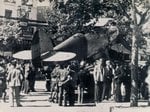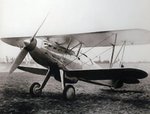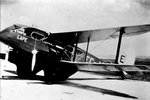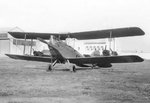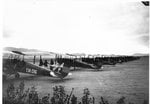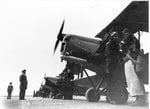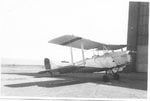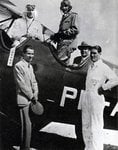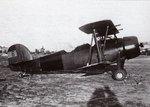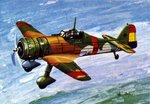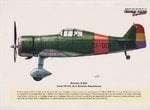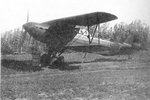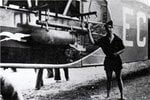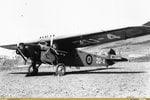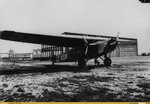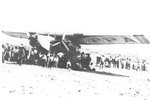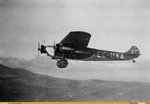- Thread starter
- #41
The Letov S-31 was a fighter aircraft produced in Czechoslovakia in the early 1930s in a number of variants. All of the aircraft had metal tubular framing and fabric covering with a metal engine cowling. The first flight of the definitive S-231 version was on March 17, 1933. After testing at the Czech flight facility at Prague-Lethany, modifications were undertaken to improve the machine's performance. It entered production the following year and began equipping Czech fighter units in June 1936. The machines remained in front line fighter status with the Czechoslovak Air Force until the German occupation of Czechoslovakia in 1939.
The only recorded combat seen by any Letov S-231 fighter was in the service of the Republicans during the Spanish Civil War. The sole S-331 and almost all of the S-231s were sold to representatives of the Spanish Republican government. During the winter of 1936/1937 the contract was signed to deliver 24 Letov S.231s to the Spanish Republicans via Lithuania. The first drawback was that before delivery 2 S-231s were lost due to accidents in Czechoslovakia, but agreement was made to replace these aircraft by the second of the three built S-131s and by the sole prototype of the S-331.The first batch of eight Letov S-231s left the port of Gdynia aboard the Dutch vessel SS Sarkani on the 9th of march 1937. This vessel reached the harbor of Santander on the 28th of March, unloading the S-231s together with 24 cannons, 15.000 guns and a lot of ammunition. After assembly, the S.231s were transferred to the Bilbao sector.
Two of these aircraft were almost immediately damaged during test flights. But this had nothing to do with lacking of the right blue prints or incorrect assembling of these aircraft, a myth that still can be found in a lot of publications. The aircraft were flown by Miguel Zambudio, Barbero and Juan Olmos among others and were involved mainly in some fighter, but mostly reconnaissance, coastal support and ground attack missions. The only recorded loss of a S-231 in aerial combat happened on the 6th of April when Juan Olmos was shot down by Gunther Lutzow of 2.J88.
The aircraft operated from the bases La Albericia, Pontejos and later from airport El Carreńo near Gijón but were step by step demolished by enemy air raids, combat damage, accidents and crashes until the last one was captured by the Nationalists on Carreño Aerodrome in October 1937. According to Spanish sources, the next batch of 9 S.231s arrived at Barcelona in May and June 1938. They were assembled at the airport of Celrá, coded CL-001 – CL-009 and formed into the 2a Escuadrilla of Grupo 71, led by Capitán José Bastida Porrán and assigned to coastal patrol and city defense duties. They operated mainly from the airfield of Bañolas. Little is known of their military operations. One was lost over sea near Valencia and CL-004 crashed near Perpignan (France) on the 10th of September 1938 during a mysterious mission. Five were destroyed on the ground by the Condor Legion during the Catalonian campaign at the aerodrome of Vilajuiga – Bañolas (Girona) during air raids and the surviving two aircraft were captured at that same airfield in February 1939. These two aircraft survived the Civil War and were pressed into service with the Ejercito del Aire with Grupo 3W, together with the S.321 that was captured at Carreño. One of them was still flying on the 1st of March 1940.
Concerning the S-331, it had to be repair before it could travel to Spain; during a demonstration in Turkey, the fuselage had suffered some damage after a full power dive in which the aircraft reached 670 km per hour. After repairs OK-VOD was shipped from Istanbul directly to Barcelona. In Spain it became the personal mount of the commander of 2a Escuadrilla of Grupo 71, Capitán José Bastida Porrán. The S.331 was a nice flying machine like the S.231-but was far more capable thanks to its powerful engine which gave it more speed, agility and nervousness. The plane was not only flown by Bastida but also by Vela Diaz who crashed this aircraft at the end of July because he ran out of fuel.
The only recorded combat seen by any Letov S-231 fighter was in the service of the Republicans during the Spanish Civil War. The sole S-331 and almost all of the S-231s were sold to representatives of the Spanish Republican government. During the winter of 1936/1937 the contract was signed to deliver 24 Letov S.231s to the Spanish Republicans via Lithuania. The first drawback was that before delivery 2 S-231s were lost due to accidents in Czechoslovakia, but agreement was made to replace these aircraft by the second of the three built S-131s and by the sole prototype of the S-331.The first batch of eight Letov S-231s left the port of Gdynia aboard the Dutch vessel SS Sarkani on the 9th of march 1937. This vessel reached the harbor of Santander on the 28th of March, unloading the S-231s together with 24 cannons, 15.000 guns and a lot of ammunition. After assembly, the S.231s were transferred to the Bilbao sector.
Two of these aircraft were almost immediately damaged during test flights. But this had nothing to do with lacking of the right blue prints or incorrect assembling of these aircraft, a myth that still can be found in a lot of publications. The aircraft were flown by Miguel Zambudio, Barbero and Juan Olmos among others and were involved mainly in some fighter, but mostly reconnaissance, coastal support and ground attack missions. The only recorded loss of a S-231 in aerial combat happened on the 6th of April when Juan Olmos was shot down by Gunther Lutzow of 2.J88.
The aircraft operated from the bases La Albericia, Pontejos and later from airport El Carreńo near Gijón but were step by step demolished by enemy air raids, combat damage, accidents and crashes until the last one was captured by the Nationalists on Carreño Aerodrome in October 1937. According to Spanish sources, the next batch of 9 S.231s arrived at Barcelona in May and June 1938. They were assembled at the airport of Celrá, coded CL-001 – CL-009 and formed into the 2a Escuadrilla of Grupo 71, led by Capitán José Bastida Porrán and assigned to coastal patrol and city defense duties. They operated mainly from the airfield of Bañolas. Little is known of their military operations. One was lost over sea near Valencia and CL-004 crashed near Perpignan (France) on the 10th of September 1938 during a mysterious mission. Five were destroyed on the ground by the Condor Legion during the Catalonian campaign at the aerodrome of Vilajuiga – Bañolas (Girona) during air raids and the surviving two aircraft were captured at that same airfield in February 1939. These two aircraft survived the Civil War and were pressed into service with the Ejercito del Aire with Grupo 3W, together with the S.321 that was captured at Carreño. One of them was still flying on the 1st of March 1940.
Concerning the S-331, it had to be repair before it could travel to Spain; during a demonstration in Turkey, the fuselage had suffered some damage after a full power dive in which the aircraft reached 670 km per hour. After repairs OK-VOD was shipped from Istanbul directly to Barcelona. In Spain it became the personal mount of the commander of 2a Escuadrilla of Grupo 71, Capitán José Bastida Porrán. The S.331 was a nice flying machine like the S.231-but was far more capable thanks to its powerful engine which gave it more speed, agility and nervousness. The plane was not only flown by Bastida but also by Vela Diaz who crashed this aircraft at the end of July because he ran out of fuel.
Attachments
-
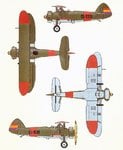 Letov S-31 001.jpg155.2 KB · Views: 1,179
Letov S-31 001.jpg155.2 KB · Views: 1,179 -
 LetovS-231ESnrCL-004profile2eEscGru.jpg38.9 KB · Views: 955
LetovS-231ESnrCL-004profile2eEscGru.jpg38.9 KB · Views: 955 -
 LetovS-231ESnrCL-009profilescan0231.jpg64.9 KB · Views: 733
LetovS-231ESnrCL-009profilescan0231.jpg64.9 KB · Views: 733 -
 LetovS-231ESnrCL-009svrartistimpres.jpg88.2 KB · Views: 634
LetovS-231ESnrCL-009svrartistimpres.jpg88.2 KB · Views: 634 -
 LetovS-231ESnr---svrcapturadofotoFR.jpg73.4 KB · Views: 692
LetovS-231ESnr---svrcapturadofotoFR.jpg73.4 KB · Views: 692 -
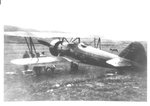 Letov S-231.jpg59.7 KB · Views: 716
Letov S-231.jpg59.7 KB · Views: 716
Last edited:

